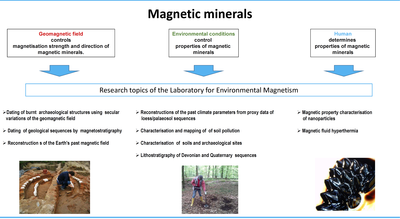Scope of research
Laboratory for Environmental Magnetism
Environmental Magnetism is the study of magnetic minerals by applying magnetic characterisation methods. These minerals have sizes ranging from a few nanometres to several micrometres and do not only occur in animals and bacteria, in burnt material from archaeological sites, in soils, in sediments and rocks, but also in particulate matter emitted from industrial and traffic sources. Consequently, Environmental Magnetism is a strongly interdisciplinary science combining biological, chemical, geographical, geophysical, mineralogical and physical principles with a wide field of applications such as for instance archaeology, climate, geomagnetism, medicine and environmental pollution.
Environmental magnetism is linked to the fact that iron is one of the most common chemical elements in the Earth's crust. It forms in association with the sulphur and oxygen magnetic minerals which are ubiquitously present in our environment. The Environmental Magnetic Laboratory follows three lines of scientific activity:
- Since the Earth has a magnetic field, the magnetisation direction and intensity of magnetic minerals, such as present in various archaeological and geological structures, provide information on temporal variations (secular variation) and polarity reversals of the past magnetic field. This phenomenon is exploited for example for archaeomagnetic and magnetostratigraphic dating.
- Magnetic iron minerals are formed during several biogeochemical processes, but also during anthropogenic processes such as the combustion of fossil fuels. Since these processes determine the magnetic properties of the minerals (type, size, quantity), the study of the latter allows conclusions about the formation environment. This phenomenon is exploited for example to help reconstruct the climate of the past, or for the mapping of contaminated soils.
- A new research line has recently been initiated dealing with the characterisation the magnetic properties of nanoparticles for biomedical applications such as contrast agent for methods of medical imaging or magnetic hyperthermia, i.e. an experimental anticancer treatment.
Visit the webpage of the Laboratory for Environmental Magnetism for further information.

The personnel of the Laboratory for Environmental Magnetism takes currently part in following projects:
- COST Action TD1402: "Multifunctional Nanoparticles for Magnetic Hyperthermia and Indirect Radiation Therapy (RADIOMAG)".
- BELSPO project: "Archaeomagnetic network for the rescue of cultural heritage in North Africa (RAPSCA)".
- Empir/Euramet project: “Towards an ISO standard for magnetic nanoparticles (MagNaStand)”.

The Laboratory for Environmental Magnetism is situated in an area free of magnetic perturbations and houses following measuring instruments:
- Magnetic Property Measurement System MPMS3 (Quantum Design)
- Automated cryogenic vector magnetometer with integrated alternating field demagnetising unit (2G Enterprises)
- Magnetic susceptibility meter Kappabridge KLY-4S (AGICO)
- and others [more info]
